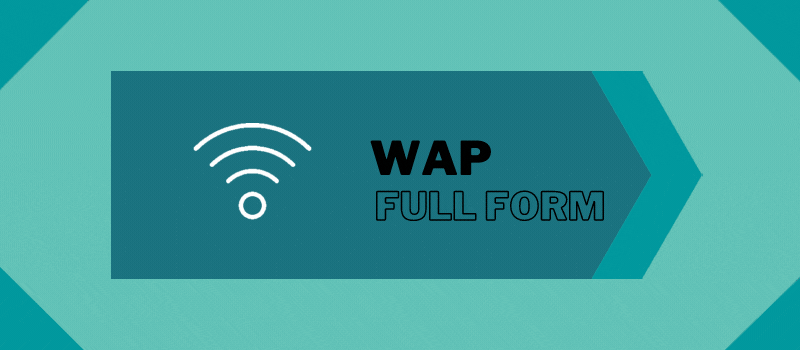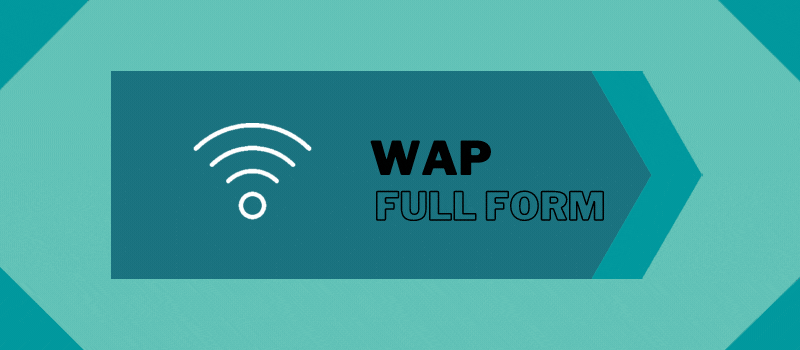Do you know the actual full form of WAP? We have 7 WAP full forms on this page for you.
WAP has multiple full forms. Here is the list of all WAP full forms:
| Wap Full Form 1 | Wireless Application Protocol |
| Wap Full Form 2 | Wireless Access Protocol |
| Wap Full Form 3 | What A Pity |
| Wap Full Form 4 | West African Percussion |
| Wap Full Form 5 | Worship and Praise |
| Wap Full Form 6 | Where are the Phones? |
| Wap Full Form 7 | Web Application Protocol |

The Most Common WAP Full Form
Do you realize how your wireless devices such as your mobile phones can use the Internet, E-mail?
Wireless Application Protocol is a widely known abbreviation for WAP.
WAP is a set of communication protocols to standardize the way Wireless Devices such as Mobile Phones, Radio Transceivers can be used for Internet access that also includes :
Email, The Web, Newsgroups, Instant Messaging.
Introduction
Even though internet access was possible before the introduction of WAP, different manufacturers have used varying technologies and WAP promised interoperability between these technologies.
At an event known as the WAP Forum, WAP was used in 1997 by Ericsson, Motorola, Nokia, and Unwired Planet.
In 2002, the WAP forum became the Open Mobile Alliance (OMA).
The Wireless Markup Language (WML) was used to create pages that could have been delivered using the WAP.
With approaches to Industry Standard, there were others too besides WAP, including Japanese i-Mode.
How Does The WAP Work?
WAP describes a protocol suite, designed to create interoperability between :
WAP equipment: such as Mobile Phones that use the Protocol
WAP software: such as WAP-enabled web browsers and network technologies.
These standards by WAP optimize mobile experiences that were previously limited by the capabilities of handheld devices and wireless networks.
WAP enhances the mobile experience through:
- The WML format for pages can be delivered using WAP
- Internet Standards that are efficient for wireless environments such as
- Extensible Markup Language (XML)
- User Datagram Protocol (UDP)
- Internet Protocol ( IP)
These are based on standards such as HTML, HTTP, and TLS but without large amounts of data.
- Binary Transmission allows for greater data compression.
- Optimization for high latency and low connection stability with low bandwidth through using a lightweight protocol stack.
WAP Model And Layers
The earlier traditional client-server model was in use and the WAP model works similarly to it. But WAP uses an additional gateway as an intermediary between the client and server.
This gateway works in a systematic format, it translates the WAP device request, from a microbrowser, into an HTTP URL request and sends it to the server over the Internet.
When the server returns a response, the WAP gateway processes and sends the webpage to the WAP mobile device as a WML file that is compatible with microbrowsers.
More Interesting Full Forms:
- Full Form Of UPSC In English and Hindi With Eligibility Criteria
- IOC Full Form: What Is IOC And What Does It Means?
- Bpo Full Form In English, Types, Advantage and Disadvantages
- Full Form Of NEET In English | What is Neet, Eligibility Criteria
- NFT Full Form: What is a Non-Fungible Token? Exchanges & Mining
- MSP Full Form and Meaning: What is MSP In Agriculture?
- Wap Full Form: 7 Full Forms of Wap With Meaning
- Full Form Of DHMCT Course: Eligibility, Institutes, Syllabus and More
- OBC Full Form: Bank Or Reservation? Complete Study – 2024
- Tet Full Form: Eligibility, Documents, Fees & Process – 2023
WAP Protocol Stacks
For interoperability of WAP devices, equipment, software, and other technologies, the WAP standard describes the following protocol stack:
- Wireless Application Environment (WAE) – It is for mobile device specifications and programming languages such as WML.
- Wireless Session Protocol (WSP) – It manages connection suspensions and reconnections.
- Wireless Transaction Protocol (WTP) – It manages the transaction support for requests and responses to servers.
- Wireless Transport Layer Security (WTLS) – It manages privacy, authentication, and data integrity through public key cryptography.
- Wireless Datagram Protocol (WDP) -It is an adaption layer for consistent data formats in the other layers and it defines how data flows to the sender from the receiver.
WAP Push
The WAP Push has been incorporated into the specification to allow the WAP content to be pushed to the mobile handset which would lead to minimal intervention.
This WAP Push is basically a specially encoded message which includes a link to the WAP address. The WAP Push was designated to be on top of Wireless Datagram Protocol (WDP) as it can be delivered over any WDP- supported bearers such as GPRS or SMS.
While receiving a WAP Push, a WAP 1.2 ( or any of the later versions) enabled handset will automatically give the user the option to access the WAP content which is also known as WAP Push SI ( service indication).
A variant which is also known as WAP Push SL ( Service Loading ) will let you directly open the browser to display the WEB Content, without user interaction which will then be without any user interaction. This behavior will definitely raise security concerns.
See this YouTube tutorial about WAP:
WAP 2.0
In 2002 another re-engineered version 2.0 was released which uses a cut-down version of XHTML with end-to-end HTTP. A WAP gateway can be used in conjunction with WAP 2.0.
The markup language defined in WAP 2.0 is the language that is processed by mobile devices as XHTML Mobile Profile ( XHTML MP) It is a subset of XHTML and a superset of XHTML Basic.
See this YouTube Video https://youtu.be/zMJMx1pI9H4 or play a video below for more info on WAP:
MMS
MMS is known as a Multimedia Messaging Service which is a combination of WAP and SMS used to allow sending of picture messages.
Why We Use WAP?
Wireless Application Protocol founded in 1999 has proposed benefits for Wireless Networks Operators, Content Providers, and End Users. Some of the reasons to use WAP are as follows:
- Wireless Network and Mobile Phone Operators – To improve the existing Wireless data services such as voicemail while also enabling the development of additional new mobile applications, wap was designed.
- Content Providers – WAP creates a market for additional applications and mobile phone functionalities for third party application developers to exploit for developers to create effective mobile device applications, writing applications in wml was proposed as a new programming language.
- End Users – End users were known to benefit from easy, secure access to online services which are such as banking, entertainment, messaging and other information on mobile devices. Intranet Information such as corporate databases and business applications are also accessed through WAP.
Having these profound benefits, yet WAP did not experience widespread adoption in several countries and its use declined around in 2010 due to the widespread HTML compatibility in mobile phones.
Success Of WAP
WAP was profoundly successful in Japan. With its rival operators KDDI ( au) and SoftBank Mobile ( previously known as Vodafone Japan), both had successfully deployed WAP technology. In the 2010s the usage of WAP and i-mode started to decline as HTML-capable smartphones became popular in Japan.
FAQ: Wap Full Form and Meaning
What does WAP mean?
WAP has many meanings and many full forms the most common is the Wireless Application Protocol.
What is WAP used for?
WAP is a set of protocols that allows data exchange of mobile cellular systems. It is device-independent. It is network-independent also.
Summary: Full Form of Wap
Thus with Wireless Application Protocol designed for micro-browsers, it enables the access of internet in the mobile devices which was resulted by the joint efforts of the various members of the WAP Forum and got merged in 2002 with other Forums resulting in the formation of Open Mobile Alliance ( OMA).
We recommended you to read:
- OBC Full Form
- Full Form Of IPS
- Full Form Of BHMS And MBBS
- DHLS Full Form
- Full Form Of PGDM
- Full Form Of ITI
- Full Form Of IAS
- Full Form Of CSAT
- Tet Full Form
- VPA Full Form
Other related categories:
Latest Post
- Full Form Of UPSC In English and Hindi With Eligibility Criteria
- Top 18 Books on Power & Influence Everyone Should Read in 2024
- Grammarly Review 2024: Why I Use It Even After 5 Years?
- GrammarlyGO Review, Tutorial, And Pricing
- How to Use Bing Image Creator to Generate AI Images
- QuillBot Review 2024: My Experience And Useful Tips
- 10 Best Rytr Alternatives 2024: Rytr.Me Competitors To Try Today
- 5 Ways – How To Find The Publisher Of A Website
- Grammarly Pricing & Plans: How Much Does Premium Cost?
- 15 Best Online Quiz Maker For Teachers (Test Makers Online) Free & Paid
- TikTok Users & Revenue 2023: Daily Monthly Active User Stats
- 10 Best Digital Board For Teachers: Smart Black/ White Board For Teaching
- 10 Best AI Detector 2023: Free & Paid Tools To Find AI Content
- 10 Best AI Essay Writers (Paper Writers) For Students & Everyone
- Youtube Student Discount On Premium In 2023: How To Get It For $6.99!

